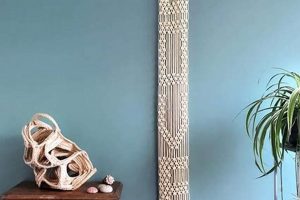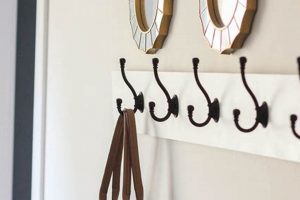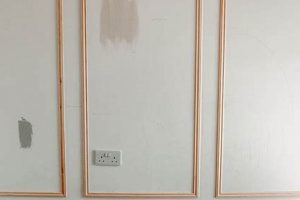The creation of decorative botanical panels using preserved moss and incorporating do-it-yourself methods constitutes a burgeoning area within interior design. Such projects involve securing various types of moss, often combined with other natural elements like wood or stones, onto a backing to form an aesthetically pleasing, textured surface. These crafted pieces serve as an alternative to conventional artwork, introducing biophilic design principles into indoor spaces. An illustrative example is a frame constructed from reclaimed wood, filled with different shades of preserved sheet moss and reindeer moss, arranged to mimic a landscape.
The rising popularity of constructing these botanical displays stems from several advantages. These creations require minimal maintenance, as the moss is typically preserved and does not necessitate watering or direct sunlight, differentiating them from living walls. They offer visual appeal and can enhance acoustic properties within a room by absorbing sound. Furthermore, the inclusion of natural elements is believed to contribute to stress reduction and an overall sense of well-being. Historically, the integration of natural elements into interior spaces has been a recurring theme, but the accessibility and adaptability of these projects have propelled their recent resurgence.
Subsequent sections will delve into the specific types of moss suitable for these projects, detailing the necessary materials and tools required for construction. Additionally, a step-by-step guide to assembling these displays, along with considerations for design and installation, will be presented. Further exploration will cover the preservation techniques employed to maintain the longevity of the botanical components and potential applications within various interior design contexts.
Crafting Durable Botanical Displays
The successful creation of long-lasting and visually appealing botanical displays hinges on several key factors. Careful planning, material selection, and execution are paramount to achieving a desirable outcome.
Tip 1: Select Preserved Moss Judiciously: Opt for high-quality, professionally preserved moss. This ensures longevity and minimizes the risk of degradation or pest infestation. Consider UV resistance for pieces exposed to sunlight.
Tip 2: Prepare the Substrate Meticulously: The backing material should be rigid, moisture-resistant, and capable of securely supporting the weight of the moss. Marine-grade plywood or PVC boards are viable options. Ensure proper sealing to prevent warping.
Tip 3: Employ Appropriate Adhesives: Use a non-toxic, pH-neutral adhesive specifically designed for bonding organic materials to prevent damage to the preserved moss. Hot glue or construction adhesive with low VOC content is recommended.
Tip 4: Plan the Design in Advance: Sketch the intended design prior to application. This allows for strategic placement of different moss varieties and ensures a balanced aesthetic. Consider the interplay of textures and colors.
Tip 5: Secure Moss Layers Thoroughly: Apply the moss in thin, even layers to prevent clumping and ensure adequate adhesion. Overlap sections slightly to create a seamless appearance. Use pins or temporary fasteners during the drying process.
Tip 6: Consider Environmental Factors: While preserved moss requires no watering, avoid placement in areas with excessive humidity, which can promote mold growth. Ensure adequate ventilation to prevent moisture accumulation.
Tip 7: Incorporate Design Depth: Vary the thickness and texture of moss to achieve visual depth. Add other preserved elements like ferns, flowers, or wood pieces for added dimension and interest.
By adhering to these guidelines, the creation of visually striking and enduring botanical displays becomes attainable. The key lies in meticulous planning, quality materials, and careful execution.
The subsequent sections will explore the design process in greater detail, providing specific techniques for achieving various aesthetic effects.
1. Moss Selection
The selection of appropriate moss varieties is a foundational element in the successful execution of decorative botanical displays. This choice directly influences the aesthetic qualities, durability, and overall visual impact of the finished piece.
- Variety and Texture
Different moss species offer distinct textures and visual characteristics. Reindeer moss, with its branching, coral-like structure, provides a three-dimensional, textural element. Sheet moss, in contrast, offers a flatter, more uniform surface. The interplay of these textures can create visual interest and depth within the artwork. For instance, a design might use sheet moss as a background to highlight the more prominent texture of reindeer moss.
- Color Palette and Dyeing
Natural moss colors range from various shades of green to brown and even white. Preserved moss is often dyed to expand the color palette. The selection of color plays a crucial role in the overall aesthetic. A monochromatic scheme might evoke a sense of tranquility, while contrasting colors can create a more dynamic and vibrant piece. An example is using varying shades of green to mimic a natural forest floor or using dyed moss to create abstract patterns.
- Preservation Method and Longevity
The method of preserving the moss significantly impacts its lifespan and appearance. Glycerin preservation, a common technique, maintains the moss’s softness and flexibility. Other methods may result in a drier, more brittle texture. Choosing moss preserved with appropriate techniques ensures the long-term stability and aesthetic appeal of the piece. Inferior preservation methods may lead to fading, crumbling, or pest infestation.
- Sourcing and Sustainability
The sourcing of moss has environmental implications. Sustainable harvesting practices minimize the impact on natural ecosystems. Ethical sourcing ensures that the moss is harvested responsibly and does not contribute to habitat destruction. Choosing moss from reputable suppliers who prioritize sustainability is a responsible decision that aligns with the eco-conscious nature of incorporating natural elements into interior design.
Ultimately, the selection of moss is a critical design decision that shapes the final outcome of any moss wall art project. Careful consideration of variety, color, preservation, and sourcing ensures a visually appealing, durable, and ethically sound piece.
2. Substrate Preparation
Substrate preparation forms the essential foundation for any successful botanical display utilizing preserved moss. Its function extends beyond merely providing a surface; it directly influences the longevity, structural integrity, and aesthetic presentation of the completed work. A poorly prepared substrate can lead to a cascade of issues, including adhesive failure, warping, and ultimately, the premature degradation of the moss artwork. The connection is direct: insufficient preparation undermines the entire project, rendering the labor and materials invested ineffective. For instance, utilizing untreated wood as a backing in a humid environment will inevitably lead to moisture absorption, warping, and potential mold growth, compromising the artwork’s structural stability and visual appeal. The use of an unsuitable substrate also prevents proper adherence of the moss, leading to detachment and a patchy, unprofessional appearance. Conversely, meticulous preparation, incorporating moisture barriers and appropriate sealing, creates a stable and durable platform that supports the moss and ensures its long-term preservation.
The practical application of this understanding is multifaceted. It necessitates a careful evaluation of environmental conditions, such as humidity levels and temperature fluctuations, within the intended display space. Selecting a substrate material resistant to these conditions is paramount. Marine-grade plywood, PVC boards, or sealed composite materials offer greater protection against moisture-related damage than untreated wood or cardboard. Furthermore, the application of a sealant or primer tailored to the chosen substrate creates a barrier against moisture penetration and enhances the adhesion of the moss. This proactive approach minimizes the risk of structural failures and extends the lifespan of the botanical display. The method of securing the moss to the substrate is also affected by substrate preparation. Roughing up a smooth surface slightly can greatly improve the bond strength of adhesives, ensuring a more secure attachment.
In summary, substrate preparation is not a perfunctory step in constructing botanical displays; it is a critical determinant of the artwork’s durability and aesthetic quality. Challenges associated with insufficient preparation include structural instability, adhesive failure, and premature degradation of the moss. Addressing these challenges requires a thorough understanding of material properties, environmental factors, and appropriate preparation techniques. By prioritizing substrate preparation, the longevity and visual impact of the botanical display are significantly enhanced, contributing to its success as a lasting piece of interior design.
3. Adhesive Application
The efficacy of adhesive application directly dictates the structural integrity and long-term aesthetic appeal of botanical displays. Improper adhesive usage can lead to moss detachment, visual degradation, and ultimately, the failure of the entire construction. The bond between the moss and the substrate relies entirely on the chosen adhesive and its application. Insufficient adhesive, or the use of an inappropriate type, creates weak points, resulting in the moss separating from the backing over time. For example, using a solvent-based adhesive on certain preserved mosses can dissolve the preservation agents, leading to discoloration and a loss of structural integrity. Conversely, a carefully selected and correctly applied adhesive ensures a durable and visually cohesive finished product.
Different types of preserved moss and substrate materials necessitate specific adhesives for optimal bonding. Porous substrates like wood often require adhesives with gap-filling properties, while non-porous surfaces like plastic or metal may need adhesives designed for bonding dissimilar materials. The application method also plays a critical role; even coverage prevents uneven stress distribution, reducing the risk of localized failures. For instance, applying a thin, even layer of a pH-neutral adhesive using a notched trowel or spray applicator promotes consistent bonding across the entire surface area. Furthermore, considering environmental factors, such as humidity and temperature, is crucial in selecting an adhesive with appropriate resistance properties. High humidity environments require water-resistant adhesives to prevent weakening of the bond.
In conclusion, adhesive application represents a critical element in the creation of botanical displays. Challenges arising from improper adhesive selection or application directly compromise the longevity and aesthetic quality of the artwork. A thorough understanding of adhesive properties, substrate compatibility, and environmental considerations is paramount. By prioritizing proper adhesive techniques, the visual integrity and durability of the botanical display can be significantly enhanced, ensuring its lasting contribution to interior design.
4. Design Composition
Design composition significantly influences the aesthetic success of botanical displays crafted using do-it-yourself methods. The arrangement of moss types, colors, and textures determines the visual impact and perceived artistic value of the finished piece. A well-considered design composition creates visual harmony, evokes specific emotions, and integrates the display seamlessly into its intended environment. Conversely, a poorly planned composition can result in a visually jarring and unappealing outcome, regardless of the quality of materials used. For example, a composition lacking balance, with an uneven distribution of colors or textures, may appear haphazard and unprofessional, detracting from the overall aesthetic.
The application of design principles such as balance, proportion, rhythm, and emphasis is crucial in creating effective botanical displays. Symmetrical balance can achieve a formal and structured look, while asymmetrical balance creates a more dynamic and natural feel. Proportion dictates the relative size and scale of different elements within the composition, ensuring visual harmony. Rhythm establishes a visual flow through the repetition of shapes, colors, or textures. Emphasis draws the viewer’s eye to a focal point within the design. Consider a composition using varying shades of green moss to create depth and dimension, with brighter, lighter-colored moss strategically placed to draw the eye and establish a focal point, implementing principles of color theory and spatial arrangement for a sophisticated effect.
Effective design composition in these projects is not merely an aesthetic choice; it is a fundamental aspect of the artwork’s overall impact and integration within a space. Challenges in achieving optimal composition can arise from a lack of planning or a limited understanding of design principles. However, by carefully considering the visual elements and applying fundamental design concepts, anyone can create a botanically inspired display with a strong aesthetic presence. The understanding of this connection bridges the gap between a mere collection of materials and a cohesive work of art.
5. Preservation Techniques
Preservation techniques are inextricably linked to the success and longevity of botanical displays constructed using do-it-yourself methods. The inherent perishability of natural moss necessitates intervention to maintain its aesthetic qualities and structural integrity, thereby enabling its use as an enduring decorative element. The following outlines key facets of preservation techniques relevant to this application.
- Glycerin Infusion
Glycerin infusion represents a widely employed method of preserving moss. The process involves replacing the natural moisture within the moss with glycerin, a humectant that retains moisture and prevents desiccation. This treatment maintains the moss’s pliability and natural color, extending its lifespan considerably. An example includes submerging cleaned moss in a heated glycerin solution for a specified duration, followed by air-drying. The implications of this technique involve a softer texture and reduced brittleness compared to air-drying alone, but also a potential for slight color alteration.
- Freeze-Drying
Freeze-drying offers an alternative preservation method that removes moisture through sublimation, preserving the moss’s original form and color with minimal shrinkage. This process involves freezing the moss and then subjecting it to a vacuum environment to remove ice crystals directly as vapor. The resulting moss retains its three-dimensional structure and natural coloration more effectively than some other methods. An example includes the preservation of delicate moss species where structural integrity is paramount. The implications of freeze-drying involve higher equipment costs but often yield superior aesthetic results.
- Stabilization with Salts
Certain salt-based solutions can be used to stabilize moss, inhibiting microbial growth and preventing decomposition. This method typically involves soaking the moss in a concentrated salt solution, followed by drying. Borax and copper sulfate are examples of salts used for this purpose. The implications of stabilization with salts include a potential for altering the moss’s texture and color, making it less flexible than glycerin-infused moss, however, it can be a cost-effective approach for larger scale installations.
- Artificial Color Enhancement
Artificial color enhancement techniques often accompany preservation methods to achieve specific aesthetic effects or to compensate for color loss during the preservation process. This may involve the use of dyes or pigments to restore or enhance the moss’s natural coloration. An example involves adding green dye to glycerin solutions during the infusion process to intensify the moss’s green hue. The implications of color enhancement necessitate careful consideration of dye toxicity and lightfastness to ensure the long-term visual quality of the artwork.
These preservation techniques, individually or in combination, are critical for transforming perishable moss into a durable medium for do-it-yourself botanical displays. The choice of technique depends on factors such as desired aesthetic qualities, cost considerations, and environmental conditions. By understanding the nuances of each method, individuals can create visually appealing and long-lasting botanical artwork.
6. Environmental Considerations
The construction of decorative botanical panels is inextricably linked to environmental responsibility. Careful consideration of sourcing, materials, and disposal practices is crucial to minimizing the ecological impact of these do-it-yourself projects. The selection of sustainable options and the implementation of responsible practices are paramount in ensuring that aesthetic pursuits do not compromise environmental health.
- Sustainable Sourcing of Moss
The extraction of moss from natural habitats can have detrimental effects on local ecosystems, disrupting delicate balances and impacting biodiversity. Sustainably sourced moss, harvested from managed environments or cultivated specifically for commercial purposes, minimizes these negative impacts. For example, purchasing moss from suppliers certified by reputable environmental organizations ensures adherence to responsible harvesting practices. The implications of choosing sustainably sourced moss extend beyond environmental protection; it promotes ethical consumption and supports businesses committed to environmental stewardship.
- Material Selection and Longevity
The materials used in the construction of botanical displays, including the backing substrate, adhesives, and frames, contribute to the overall environmental footprint. Selecting durable, long-lasting materials reduces the need for frequent replacements, minimizing waste generation. Repurposing reclaimed wood or utilizing recycled materials for the backing substrate represents a sustainable alternative to virgin materials. The implications of prioritizing durability and recycled content extend to resource conservation and waste reduction, aligning with principles of circular economy.
- Minimizing Chemical Usage
The preservation and coloration of moss often involve the use of chemical treatments, some of which may pose environmental or health risks. Opting for preservation methods that utilize non-toxic, biodegradable alternatives minimizes the potential for harmful chemical release into the environment. For instance, utilizing natural dyes derived from plant extracts instead of synthetic pigments reduces the risk of water contamination. The implications of minimizing chemical usage promote ecological health and safeguard human well-being, reflecting a commitment to responsible material selection.
- End-of-Life Disposal and Recycling
The eventual disposal of botanical displays necessitates responsible handling to minimize environmental contamination. Designing modular constructions that allow for the separation and recycling of individual components facilitates responsible waste management. Composting the moss and recycling the backing material represents environmentally sound disposal options. The implications of designing for end-of-life recycling and promoting composting practices support waste reduction and resource recovery, contributing to a closed-loop system.
These considerations form an integral aspect of creating botanical displays. Making conscious choices in material sourcing, chemical usage, and disposal demonstrates a commitment to environmental sustainability, ensuring that the creation of aesthetically pleasing artwork does not compromise ecological health and resource conservation. These practices collectively minimize the environmental impact associated with crafting moss wall art.
Frequently Asked Questions
This section addresses common inquiries regarding the construction of decorative botanical panels, offering practical insights and clarifying misconceptions surrounding material selection, preservation, and installation practices.
Question 1: What is the expected lifespan of a botanical display constructed with preserved moss?
The longevity of these displays depends largely on the quality of materials and environmental conditions. Properly preserved moss, protected from direct sunlight and excessive humidity, can maintain its aesthetic appeal for several years, potentially exceeding five years with minimal maintenance.
Question 2: Is special lighting required for botanical displays?
Preserved moss does not require special lighting. Direct sunlight can cause fading and degradation of the moss. Indirect or artificial light is sufficient for maintaining the display’s visual qualities.
Question 3: Can botanical displays trigger allergies?
Preserved moss is typically treated to minimize allergenic properties. However, individuals with sensitivities to mold or other organic materials may experience reactions. Adequate ventilation and dust control are recommended.
Question 4: What are the options for cleaning a botanical display?
Dust accumulation can be addressed with gentle vacuuming using a soft brush attachment. Avoid excessive moisture, which can damage the preserved moss. Compressed air can also remove loose debris.
Question 5: Is the construction of these projects environmentally sustainable?
The environmental impact depends on material sourcing and disposal practices. Choosing sustainably harvested moss, utilizing recycled materials, and minimizing chemical usage contribute to a more environmentally responsible construction process.
Question 6: How does one prevent mold growth on botanical displays?
Mold growth is primarily prevented by maintaining low humidity levels and ensuring adequate ventilation. Avoiding placement in damp environments, such as bathrooms, is crucial. If mold is detected, gentle cleaning with a diluted antifungal solution may be necessary.
These inquiries serve as a starting point for understanding the nuances of botanical display construction. Prioritizing quality materials, proper preservation techniques, and appropriate environmental controls ensures the creation of durable and aesthetically pleasing artwork.
The subsequent section delves into potential applications of botanical displays within various interior design contexts, showcasing their versatility and adaptability.
Conclusion
The preceding exploration of “moss wall art diy” has underscored the multifaceted nature of these projects, encompassing considerations ranging from material sourcing and preservation techniques to design composition and environmental responsibility. The construction of visually appealing and enduring botanical displays necessitates a comprehensive understanding of these factors, emphasizing the importance of informed decision-making at each stage of the process.
The continued adoption of sustainable practices and the pursuit of innovative preservation methods will further enhance the viability and ecological integrity of “moss wall art diy” as a form of interior decoration. Continued diligence in these areas is crucial for ensuring the long-term success and societal value of this increasingly popular art form.







